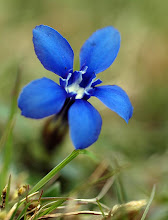Some seeds need to be sown while others - like wild oat Avena fatua - sow themselves. This is a wild oat fruit (or, to be botanically accurate a caryopsis) in the dry state. It's equipped with a long awn (which is extension of the floret in which the fruit formed and in which it is shed), that's bent at a right angle about a quarter of the way along it's length.
When the caryopsis falls to the ground and gets wet - from a passing shower of rain, for example, that bent awn straightens, then bends again as it dries out. The picture above shows the same fruit, but now it's been moistened and the awn has straightened. As the awn bends and straightens it also rotates, because the awn is constructed from a helix of fibres that twist and generate torsion as they dry (see below).

The outer coat of the floret containing the caryopsis is equipped with this arrowhead of stiff hairs at the tip ....

.....which readily catch in fur and feathers and help disperse the seed, but also anchor it in crevices in the soil when it falls to earth.
There is also a beard of stiff hairs running up the groove in the caryopsis. As the awn rotates .....
.... with the expansion and contraction of this helical tube of spiral fibres that it's constructed from, it levers the caryopsis further into soil crevices. Those stiff hairs on the caryopsis help to anchor it in the soil, ratcheting it in ever deeper until it's in a moist enough position to germinate and put down roots.
This is a seed that sows itself.
The video below shows a group of wild oat caryopses writhing as their awns dry out and begin to rotate.


















Fascinating - I never knew that.
ReplyDelete